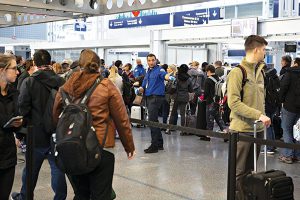Bloomberg
US aviation authorities are years behind on updating the critical-alert system that failed spectacularly last month, causing thousands of flight disruptions. Critics say the delay is a threat to passenger safety.
House lawmakers are scheduled to hold a hearing on aviation safety at which they’re likely to raise questions about the January 11 meltdown of the Federal Aviation Administration’s Notice to Air Missions system, or Notam. While the FAA has taken steps to ensure that the platform won’t fail in the same way again, its problems go far deeper after years of neglect, including issues that contributed to one of
the worst near-disasters in US
aviation history six years ago.
Notam produces bulletins for pilots flying in the US about any safety issues along a route. They could include anything from broken airport lights to an emergency closing of airspace, such as when the FAA temporarily suspended flights along the US East Coast on February 4 during the military mission to destroy a Chinese surveillance balloon. Pilots are required to check them before departing.
But according to government records, industry groups and dozens of pilot reports, the system is packed with unnecessary information that’s difficult to sort, and its antiquated language makes the bulletins hard to comprehend. The FAA acknowledges the shortcomings and plans improvements, but acting Administrator Billy Nolen notified House lawmakers January 27 that fixes wouldn’t be fully completed until 2030. Congress first ordered the agency to begin upgrading the Notam system in 2012. The 2030 date is several years later than industry groups were told as recently as last year.
The soonest the FAA can complete the work is 2030 “based on the current funding,†the agency said in a statement.
The FAA is looking for ways to accelerate the work, it said.
The FAA has made progress in modernising the bulletins in recent years, creating a more user-friendly interface and cutting the volume of notices. The agency is seeking to improve it further, and asked for $29.4 million this year to address “failing vintage hardware.â€
Overall, the FAA’s $3 billion budget for facilities and equipment — the spending category where any improvements to Notams would come from — is the same as 2009 levels, even without accounting for inflation. Combined with unexpected costs associated with the Covid-19 pandemic, the lack of funds has made it difficult for the FAA to commit to projects such as updating Notams.
The failure in January occurred when employees of the government contractor hired to maintain the Notam system, Spatial Front Inc., accidentally deleted critical data, the FAA has said. That led to problems that brought down the main and backup platforms. The FAA expects to replace the 30-year-old computer system by 2025, Nolen told lawmakers.
A separate issue for pilots is that Notams, which have been in place since before the dawn of the jet age, use nomenclature that is reminiscent of an old teletype message. Most text is capitalised and words are often abbreviated, making the various warnings and alerts — which can number in the dozens for any given flight — difficult to absorb and sort through.
Dozens of anonymous pilot reports to the National Aeronautics and Space Administration’s Aviation Safety Reporting System in recent years echo similar concerns.
In May 2022, an airline pilot said “I would never have time to take off in the same day†if he or she had to plot every radio tower or crane listed in the notices for just one airport.
That same year saw one of the worst near-disasters in US history, an incident blamed at least in part on pilots of an Air Canada flight from Toronto to San Francisco who missed a notice about a closed airport runway buried in 27 pages of Notams and other bulletins. As a result, the cockpit crew almost landed on a taxiway crowded with other airliners, flying fewer than 20 feet over a parked jet loaded with passengers.
The crew’s failure to review the Notam announcing the closing of the runway and its “ineffective presentation†were factors in the cause, the NTSB found in a 2018 report.
Six years earlier, Congress had passed legislation that included several provisions calling on FAA to modernise the Notam system, including requiring it to adopt standards for clear language set by the International Civil Aviation Organization, an arm of the United Nations.
The agency has acknowledged it hasn’t yet fully complied with the law or 2018 legislation that added requirements, but says it’s taking “concrete steps†to upgrade it and has elevated it to a top priority.
 The Gulf Time Newspaper One of the finest business newspapers in the UAE brought to you by our professional writers and editors.
The Gulf Time Newspaper One of the finest business newspapers in the UAE brought to you by our professional writers and editors.
